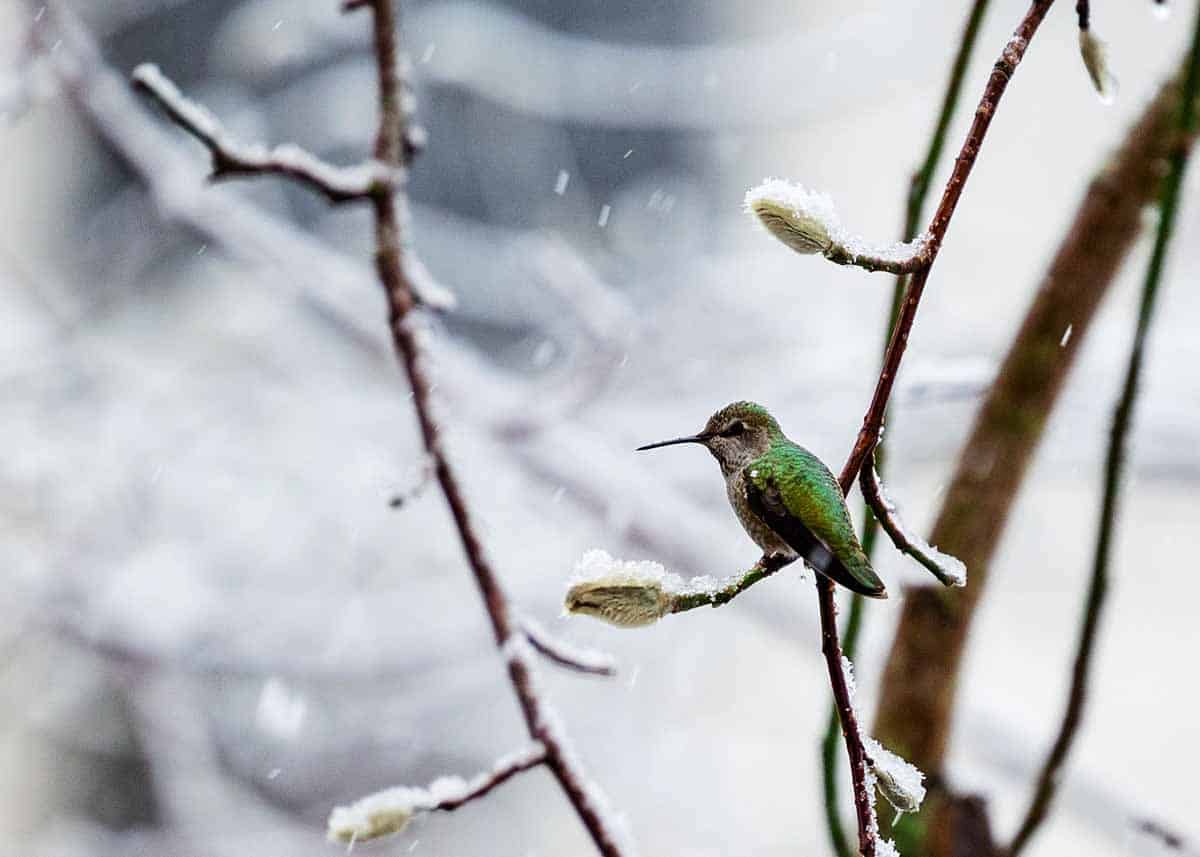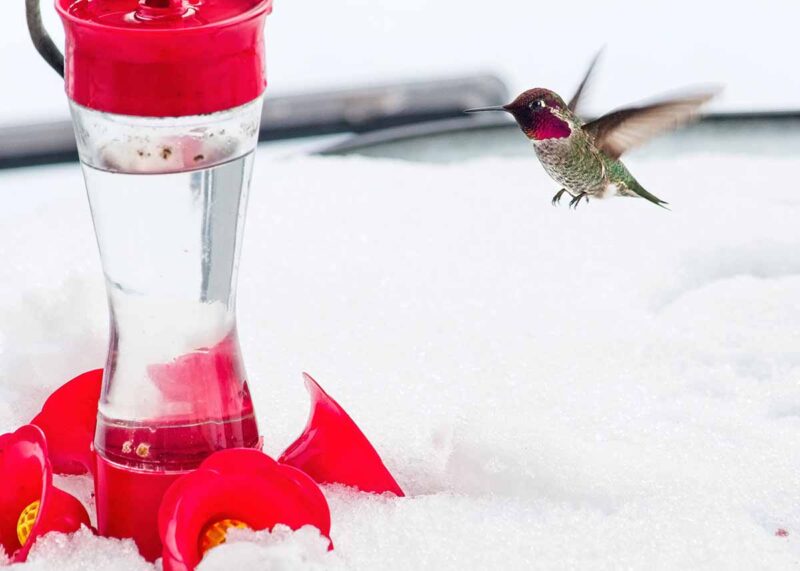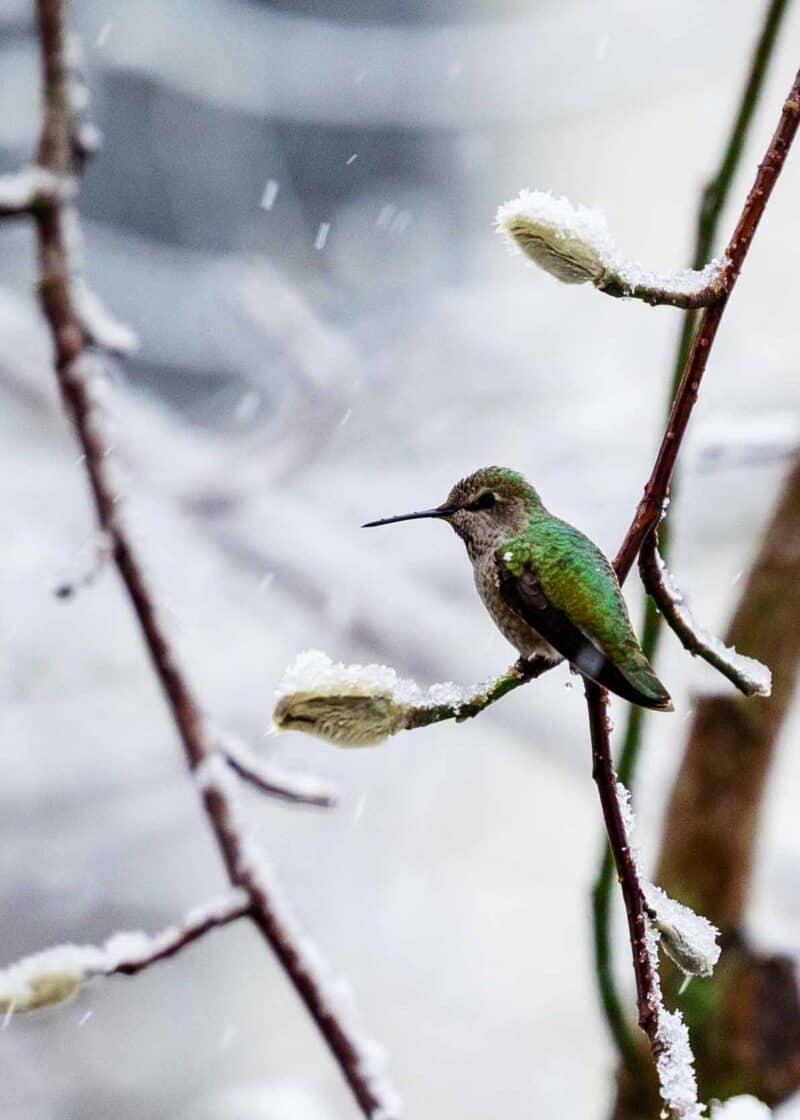With the chill of winter in the air, you might wonder what hummingbirds do to survive the cold months. What do hummingbirds do in the winter? Here’s how they protect themselves from winter weather.
How do hummingbirds survive winter? Hummingbirds migrate to warmer climates. Hummingbirds can’t survive freezing temperatures because of their high metabolism and delicate structure.

Because hummingbirds don’t hibernate, they must go south. But they do experience a hibernation-like state, known as torpor while sleeping.
Table of Contents
What Do Hummingbirds Do In The Winter? Migration
Every winter, millions of hummingbirds embark on a fantastic journey southward, migrating to regions where the weather is more hospitable. Although these tiny birds weigh about the same as a penny, they can fly great distances, often covering more than 1,000 miles in a single trip.
However, the journey has its hazards, as strong winds can impede their progress. Hummingbirds traveling longer distances (Canada and northern US) must still find food to fuel their trip south.
Despite the challenges, they successfully make the trip each year, returning to their northern homes in the spring. The annual hummingbird migration is truly one of nature’s most astounding feats.
How Do Hummingbirds Feed During Migration?
Migrating hummingbirds must significantly increase their nectar intake to compensate for the lack of food sources along their journey.
They consume approximately twice as much nectar daily during migration as they do when not migrating.
Hummingbirds feed more frequently and for extended periods to ensure they get enough nectar.
Some hummingbirds even change their migration route to make sure they’ll be able to find enough food. By increasing their nectar intake, migrating hummingbirds can fuel their long journeys and survive until they reach their destination.
Do Hummingbirds Rest During Migration?
You might think that because hummingbirds are such tiny creatures, they could flap their wings the whole way during their migration. But even these little birds need to rest during their long journey.
I’ve read in more than a few places that “hummingbirds stop for a few minutes every hour or so to eat and drink”. But from what I can tell, this isn’t true.
In fact, before migrating, hummingbirds experience hyperphagia. This is a condition in which they overeat and gain enormous amounts of weight.
Bird scientists have calculated that the fat added through pre-migration feeding frenzies is enough to fuel nonstop flying nearly 600 miles for a typical hummingbird. Ruby-throats that are believed to migrate from southern Florida to Mexico’s Yucatan Peninsula could complete their entire migration (about 525 miles) without needing to re-fuel!
JourneyNorth.org
And at night, they’ll find a safe place to roost. Do hummingbirds sleep?
Despite what some sites claim, hummingbirds don’t form flocks when migrating. Rather, they travel alone.
Do Hummingbirds Return to the Same Place Every Year?
Many hummingbirds return to the same gardens or feeders every year. Additionally, they frequently stop at the exact locations and arrive on the same day.
This incredible sense of direction allows these tiny birds to travel vast distances and return to their homes yearly.
Do All Hummingbirds Migrate?
Different from all hummingbird species, Anna’s Hummingbirds don’t migrate. Because of backyard feeders and increased exotic flower trees, Anna’s Hummingbirds live year-round up the west coast, from Mexico to southern Canada.

How Do Hummingbirds Survive Winter?
Finding Food
In the winter, most hummingbirds head south to find food and warmer temperatures. They follow cues like changes in temperature and the amount of daylight to decide when to migrate.
Once they arrive at their wintering grounds, they use various methods to find food.
- Hummingbirds have excellent eyesight, and they often spot flowers from a distance. Studies indicate that hummingbirds can see numerous ultraviolet colors.
- They also have a keen sense of smell, which they use to locate nectar-producing plants.
Thanks to these skills, hummingbirds can survive even in new surroundings.
Staying Warm
While hummingbirds do everything possible to avoid the cold, sometimes there will be a late spring snowstorm.
But what do hummingbirds do to keep warm? By fluffing its feathers, the hummingbird traps warm air in its fluffed feathers, shielding its body from the chilly air around it.
The hummingbird also has a unique circulatory system that helps to keep its body temperature consistent. The hummingbird can enter into a state of torpor, lowering its body temperature and metabolic rate until the warmer weather arrives.
Hummingbirds don’t hibernate, like these cold-hardy animals do.
How Cold Is Too Cold for Hummingbirds?
Hummingbirds need warm weather and can’t tolerate much cold weather. As a result, they can experience health problems when the temperature drops below 50 degrees Fahrenheit (10 C).
They may have difficulty flying, and their metabolism slows down, so they have difficulty generating heat. As a result, hummingbirds may be more susceptible to predation. And they can’t feed sufficiently to survive.

Your Turn
Although we may not see hummingbirds in the winter, they are still hard at work down south. They wisely migrate to warmer climates. Hummingbirds are amazing creatures that continue to surprise us with their abilities.
Have you seen hummingbirds preparing for migration? Or maybe a rare hummingbird in winter?
Drew Haines is an animal enthusiast and travel writer. She loves to share her passion through her writing.
She graduated high school at sixteen and started her own business, Everywhere Wild Media. And she runs Everywhere Wild and JustBirding. She also guest blogs on Storyteller.Travel
She lived in Ecuador for 6 years and explored the Galapagos Islands. Currently based in N.S., Canada.
